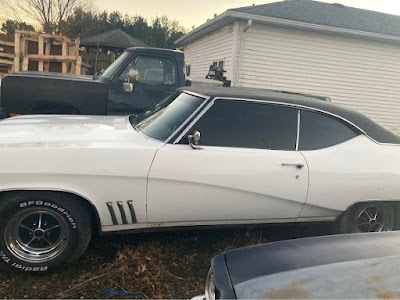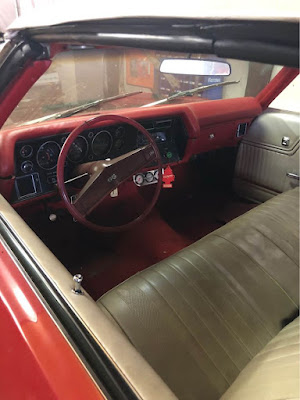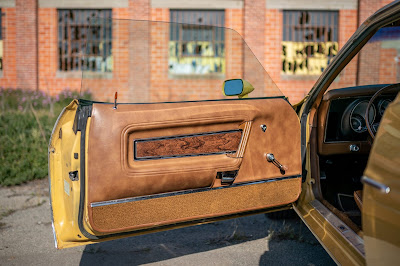Ask a Ford Mustang cognoscenti to name their favorite and they'd probably have a hard to choosing between the originals, the Fox-bodies, S-197's and the most recent iteration. Ask them what Mustang they like least and no doubt they'd say the 1974-1978 Mustang "II's". If they even mention them. These "big" 1971-1973 Mustangs get more than their fair share of disdain too. Our subject here is a 1973 Mustang Grande. "Grande" was a luxury trim option and not a descriptor of the car's size or weight.
I think the vitriol these get is a bit unfair. In my opinion, in a vacuum at least, these boats or "biggest of all time Mustangs", are just as handsome if not more so than any Torino or LTD coupe of the same time period. I think if Ford badged these as a "Thunderbird" they would have been touted as seminal, watershed designs. Then again, the early 1970's were still a time period when Detroit held steadfast to their "bigger is better" axiom. Even if, in retrospect, it was the tail-end of it.
Where these Mustangs run aground is in comparison to the lithe ponies that came before them. Although the 1969-1970 Mustang pushed the envelope itself as to what a "pony car" was. And this dyed-in-the-wool GM girl will tell you that a 1970 Mustang is the embodiment of cool meanwhile these are...well...just pretty nice. Although, frankly, a 1970 Mustang pales in comparison to my beloved Chevrolet Camaro's and Pontiac Firebirds. Even Plymouth Barracuda's and Dodge Challenger's.
So, how did the Mustang get so big and heavy and so quickly? I mean, wow - four practically clean sheet designs in eight model years with each one getting longer, wider and heavier? Well, let's take a step or two backwards and shed some light on the era these were, ahem, foaled in.
Ford had sold more than 1.4 million Mustangs between April of 1964 and the end of the 1966 model year, but starting in 1967, competition from GM and even Ford itself with a Mercury knock-off of the Mustang had taken the gallop out of sales. Choice is great for the consumer, not good for business.
Furthermore, insurance companies surcharging for anything remotely construed as a performance car slowed sales of muscle and sporting cars to a near standstill. To that end, you have to applaud Ford for attempting to go where they perceived the buying public was going what with their growing fondness for larger, more "luxurious" automobiles.
Even if these Mustangs look like a third-generation Corvette and a 1971 AMC Javelin got jiggy one night. You either get this design or you hate it. I never not "got it" although, again, there's certainly better-looking domestic designs from this time period.
"Howie", a peripheral member of a group of guys I called "friends" in high school, had a '73 Mustang just like this save for his having full wheel covers and not the luscious alloys this one has. Compared to the placid, non-descript appliances of varying degree and condition any of us were driving at the time, especially me in my
shit-box, squeaky Comet, it was a freaking rock star. As always, everything is relative.
Howie was socially awkward, nerdy and painfully-shy-around-girls; a Dungeons and Dragons type doing his best to hang with an obnoxious group of sword-swinging alphas. We despairingly referred to him as "How Weird". A couple of years older than we were, people-pleaser that he was, he delighted in buying us beer and liquor and herding us around in his Mustang. How as many as five us shoehorned into that big-little car is a mystery to me now.
The two or three of us that knew a thing or two about cars were very enamored with it. The hype around it was so extreme that each time I drove it my excitement overshadowed my ability to appreciate it for what it was. Or, frankly, see it for what it wasn't. "Holy shit! I'm driving Howie's car! But I'm sitting too low, I can't see over the too-tall dashboard, the view out the back sucks and it handles like a bathtub full of water with square wheels. But I'm driving Howie's car!"

Howie bragged that his Mustang had the exotic sounding "351 Cleveland". Ford built the "Cleveland", Cleveland, Ohio not far from where I live now, in various guises from 1969 through 1974 but the "351C" in Howie's car was the white bread, low revving, low-compression "2V" version. Making all of 164 net-brake-horsepower, it made 276 foot-pounds of torque just off idle and driven purposefully as Howie did, meaning he had the most leaden of right feet, the car seemed hedonistic-ally fast. In reality, especially in light of how powerful even the lowliest of new cars are today, those numbers are far from adequate to haul around a 3,500-pound automobile. Especially packed with a good thousand pounds of sweaty, farty teenagers.

To impress us "kids", Howie took any and all reckless, wild chances he could at the drop of a hat. I cringe now knowing that we were just lucky that nothing ever happened. I see stories of cars packed with kids crashing and there being serious injuries if not fatalities and my heart sinks. That could have been us.
Snaps to Howie, though, risks be damned, for being able to handle that car the way he did.
I ran into him years after that group had dissolved into adulthood and conversation went straight to cars, naturally. I kept the conversation going talking about his driving exploits, I even went so far as to flatter him telling him I thought he was a "great driver". Right or wrong, in certain situations, I have a penchant for telling people what they want to hear. In reality I thought he was the most dangerous driver I had ever ridden with save for someone that I knew was drunk behind the wheel.
When I asked him whatever happened to that Mustang, he shrugged his shoulders and laughed saying, "oh, that thing. I wrecked it." I wasn't surprised. And I felt very lucky.












































